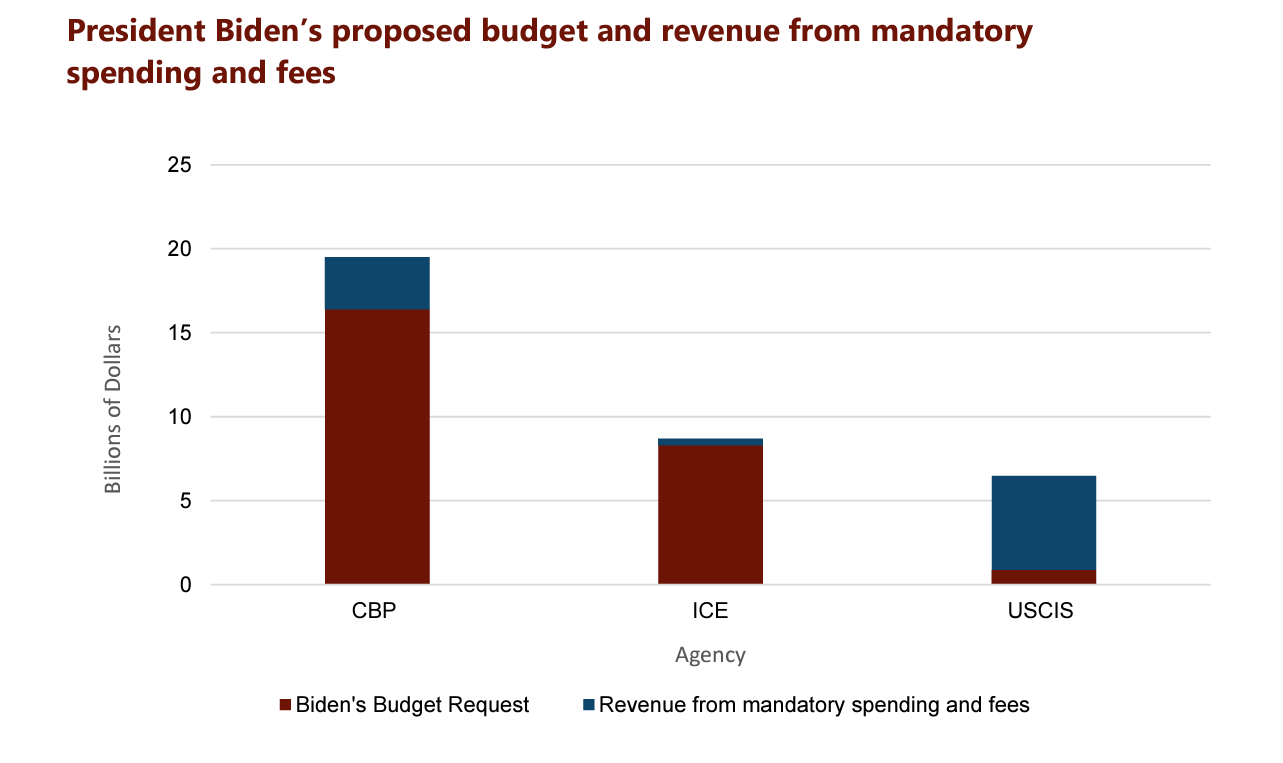Biden’s DHS Budget Request Underscores a Punitive Approach to Immigration
By Juan Gomez:
Ahead of the 2020 election, President Biden spent months on the campaign trail decrying President Trump’s punitive and inhumane approach to immigration. Yet Biden’s immigration policies mirror those of his predecessor, undermining hope among immigrant advocates and families that a new administration would bring a fairer immigration system.[1]
An analysis of the Biden Administration’s FY 24 budget request for the Department of Homeland Security (DHS) shows that the president has proposed increases over the previous year in discretionary spending for U.S. Customs and Border Protection (CBP) and U.S. Immigration and Customs Enforcement (ICE), the DHS agencies that oversee immigration detention, enforcement, and deportations.
At the same time, the administration has requested less for U.S. Citizenship and Immigration Services (USCIS), the DHS agency that processes applications for visas, asylum, naturalization, and other forms of lawful immigration. The majority of USCIS’s budget relies on mandatory spending and fees immigrants must pay to have their applications processed, placing an undue financial burden on people with low incomes. In addition, the administration has requested less funding to support Alternatives to Detention (ATD), programs that allow new arrivals to reside here and receive support from community-based organizations while waiting for their case to be processed through immigration court.[2]
An emphasis on harsh enforcement
The Biden Administration has requested $16.4 billion for CBP, a $1.2 billion or 8 percent increase from the previous year’s request, and $8.3 billion for ICE, a $300 million or 4 percent increase from the previous year’s request. The administration has also proposed a new $4.7 billion contingency fund for CBP and ICE officials to use at their discretion once certain conditions have been met. Biden’s budget request—including the continency fund—would provide these two agencies with up to $29.4 billion in discretionary funding, surpassing the $25.5 billion Trump requested for these two agencies in FY 2021.
By contrast, the administration has requested $865 million for USCIS, nearly $50 million or 5 percent less than the amount requested last year. The administration has also requested $363 million for ATD programs, 30 percent less than last year’s request. According to DHS’s own analysis, ATD programs are more cost effective than detention: less than $8 per day for each participant compared to $150 per day.[3]
USCIS’s disproportionate reliance on user fees
Each agency’s total projected budget includes both the president’s budget request and additional revenues from mandatory spending and fees. A look at the USCIS total budget reflects its model of disproportionate reliance on application fees compared to other agencies. Mandatory fees, largely from immigrant applicants, make up more than 85 percent of the agency’s $6.5 billion total projected budget. This compares to CBP’s budget in which fees and other mandatory spending comprise just under 16 percent of the total and to ICE’s budget in which fees and mandatory spending are about 5 percent of the total. In fact, the Biden Administration has proposed raising USCIS application fees this year, a move that will create hardship for immigrant families and communities, who are more likely to live below the poverty line than the general population.[4]
Even with fees being the main source of revenue, USCIS faces an unprecedented backlog in processing applications. Comparing the total budgets of these three DHS agencies reinforces the administration’s emphasis on immigration enforcement. CPB’s total budget is triple that of USCIS, and the ICE budget exceeds it by more than $2 billion.

| Agency | Total projected budget | Biden’s budget request | Revenue from mandatory spending and fees |
| CBP | $19.5 billion | $16.4 billion | $3.1 billion |
| ICE | $8.7 billion | $8.3 billion | $400 million |
| USCIS | $6.5 billion | $865 million | $5.6 billion |
Recommendations:
The Biden Administration’s focus on increased immigration enforcement is not only more costly but also less effective in processing those arriving in the United States. More funding for immigration enforcement actions will exacerbate the backlog of immigrants in the system and block those seeking asylum from getting their claims processed in a timely manner.[5] To support a humane and effective system, we recommend that the administration instead:
- Cut funding for immigration enforcement actions.
- Redirect funds to USCIS to decrease the fees immigrants must pay and increase the number of cases that can be processed.
- Allocate and increase funding for community-based alternatives to detention.
Endnotes
[1] Maria Sacchetti and Nick Miroff, Immigration pivot shows Biden facing hard reality of border politics, Washington Post, January 2023, https://www.washingtonpost.com/immigration/2023/01/07/biden-immigration-border/.
[2] U.S. Immigration and Customs Enforcement, What are Alternatives to Detention?, February 2023, https://www.ice.gov/features/atd.
[3] U.S. Immigration and Customs Enforcement, What are Alternatives to Detention?, February 2023, https://www.ice.gov/features/atd.
[4] Juliana Zhou, CLASP Urges USCIS to Withdraw Proposed Immigration Fee Increases, Center for Law and Social Policy, March 2023, https://www.clasp.org/publications/testimony/comments/clasp-urges-uscis-to-withdraw-proposed-immigration-fee-increases/.
[5] Muzaffar Chishti and Julia Gelatt, Mounting Backlogs Undermine U.S. Immigration System and Impede Biden Policy Changes, Migration Policy Institute, February 2022, https://www.migrationpolicy.org/article/us-immigration-backlogs-mounting-undermine-biden.